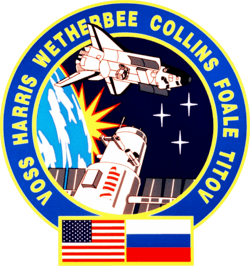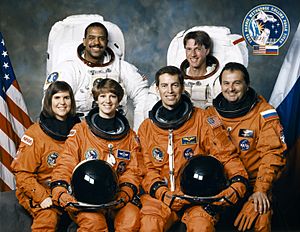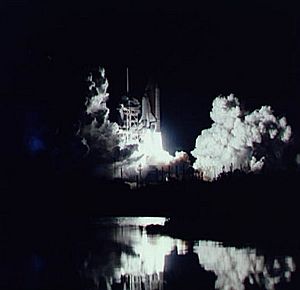STS-63 facts for kids

View from Discovery of Mir with the Progress-M 225 (top) and Soyuz-TM Vityaz (bottom) spacecraft
|
|
| Mission type | Research Mir rendezvous |
|---|---|
| Operator | NASA |
| Mission duration | 8 days, 6 hours, 28 minutes, 15 seconds |
| Distance travelled | 4,816,454 kilometers (2,992,806 mi) |
| Orbits completed | 129 |
| Spacecraft properties | |
| Spacecraft | Space Shuttle Discovery |
| Payload mass | 8,641 kilograms (19,050 lb) |
| Crew | |
| Crew size | 6 |
| Members |
|
| Start of mission | |
| Launch date | 3 February 1995, 05:22:04 UTC |
| Launch site | Kennedy LC-39B |
| End of mission | |
| Landing date | 11 February 1995, 11:50:19 UTC |
| Landing site | Kennedy SLF Runway 15 |
| Orbital parameters | |
| Reference system | Geocentric |
| Regime | Low Earth |
| Perigee | 275 kilometres (171 mi) |
| Apogee | 342 kilometres (213 mi) |
| Inclination | 51.6 degrees |
| Period | 92.3 minutes |
  Left to right - Seated: Voss, Collins, Wetherbee, Titov; Standing: Harris, Foale |
|
STS-63 was a very important space mission. It was the second mission in the US/Russian Shuttle-Mir Program. This flight marked the first time an American Space Shuttle met up with Russia's Mir space station in orbit.
The mission was called the 'Near-Mir' mission. The Space Shuttle Discovery launched from Launch Pad 39B in Florida on February 3, 1995. This was a night launch and Discovery's 20th trip to space. It was also special because Eileen Collins became the first female pilot of a Space Shuttle. Plus, it included the first spacewalks for a UK-born astronaut, Michael Foale, and an African-American astronaut, Bernard A. Harris, Jr.. The mission successfully deployed and retrieved a science platform called Spartan-204. It also practiced getting close to Mir to prepare for STS-71, which would be the first mission to actually dock with Mir.
Contents
Meet the Astronauts: STS-63 Crew
The STS-63 mission had a crew of six skilled astronauts. They worked together to complete all the mission's goals.
| Position | Astronaut | |
|---|---|---|
| Commander | Third spaceflight |
|
| Pilot | First spaceflight |
|
| Mission Specialist 1 | Second and last spaceflight |
|
| Mission Specialist 2 | Third spaceflight |
|
| Mission Specialist 3 | Second spaceflight |
|
| Mission Specialist 4 | Third spaceflight |
|
Spacewalks on STS-63
During the mission, two astronauts performed a spacewalk, also known as an Extravehicular Activity (EVA).
- Foale and Harris – EVA 1
- EVA 1 Start: February 9, 1995 – 11:56 UTC
- EVA 1 End: February 9, 1995 – 16:35 UTC
- Duration: 4 hours, 39 minutes
Mission Goals and Achievements
The main goal of STS-63 was to practice getting close to the Russian space station Mir. This was a test run for future missions that would actually connect with Mir. The team needed to check their flight methods, communication systems, and navigation tools. This would make sure future dockings were safe.
Other important goals included running experiments inside a special module called SPACEHAB-3. They also had to deploy and then retrieve a free-flying science platform called Spartan-204. Spartan-204 was designed to study light from space in the far ultraviolet range. Two astronauts were also planned to do a five-hour spacewalk.
Experiments and Payloads
Several science experiments and payloads flew on STS-63. These included the Cryo Systems Experiment (CSE) and the Shuttle Glow (GLO-2) experiment. There was also the Orbital Debris Radar Calibration Spheres (ODERACS-2). This helped track small pieces of space junk. Other experiments were the Solid Surface Combustion Experiment (SSCE) and the Midcourse Space Experiment (MSX).
Getting Close to Mir: The Rendezvous
Starting on the first day, Discovery performed daily engine burns to slowly get closer to Mir. The original plan was to get within 10 meters (33 feet) of Mir. Then, Discovery would fly around the station. However, some small thrusters on Discovery started leaking. These thrusters are used for moving the Shuttle in space.
Despite the leaks, after a lot of discussion between US and Russian teams, they decided it was safe to continue. The crew was given permission to approach Mir. Radio contact with Mir was made early. Astronaut Vladimir G. Titov, who had lived on Mir before, spoke excitedly with the three cosmonauts aboard: Aleksandr Viktorenko, Yelena Kondakova, and Valeri Polyakov.
Discovery stopped about 122 meters (400 feet) from Mir. Commander James D. Wetherbee then carefully guided Discovery to just 11 meters (36 feet) away. This closest approach happened on February 6, 1995. Wetherbee said, "As we are bringing our spaceships closer together, we are bringing our nations closer together." He added that next time, they would shake hands.
Cosmonaut Viktorenko replied, "We are one. We are human." After this close approach, Discovery moved back to 122 meters. It then flew one and a quarter loops around Mir. The Mir crew reported no shaking or movement from Discovery's approach.
Science in Space: SPACEHAB-3
The SPACEHAB-3 module was located in Discovery's front cargo bay. It was making its third flight on the Shuttle. This module carried 20 different experiments. These included studies on biotechnology, new materials, and technology demonstrations. Improvements were made to SPACEHAB to make it easier for the crew to use. For example, a new video system meant astronauts didn't have to spend as much time on video operations.
One interesting experiment was Astroculture, which studied how plants grow in space. This research helps us understand how to grow food for astronauts on long missions. It also has uses on Earth, like creating energy-efficient lighting. Another experiment, Immune, looked at how spaceflight affects the immune system. This could help develop treatments for diseases that weaken the immune system.
Tracking Space Junk: ODERACS-II
On the second day of the mission, the crew released the Orbital Debris Radar Calibration System-II (ODERACS-II). This system helps scientists track small pieces of space debris, or "space junk." Six target objects were released into orbit. Ground radars tracked these objects. This helps calibrate the radars to better track tiny pieces of debris in low Earth orbit.
Spartan-204: A Free-Flying Telescope
Also on flight day two, the crew used the robot arm to lift SPARTAN-204 from the cargo bay. SPARTAN stayed on the arm for a while to observe how the Shuttle's engines glowed in space. Later, SPARTAN-204 was released to fly freely for about 40 hours. During this time, its special camera studied gas and dust between stars. This material is where new stars and planets are formed.
SPARTAN-204 was also used during a spacewalk. Astronauts Foale and Harris practiced handling the heavy SPARTAN. This helped them rehearse techniques for building space stations. However, they got very cold during this part of the spacewalk, which happened during a night pass. So, they had to cut short the practice. This spacewalk was the 29th for the Shuttle program. It was the first for both a UK-born astronaut and an African-American astronaut.
Coca-Cola in Space
The STS-63 mission also carried a special experiment involving Coca-Cola! BioServe Space Technologies developed a device called the Fluids Generic Bioprocessing Apparatus-1 (FGBA-1). This machine could dispense pre-mixed soda for the astronauts to drink. Scientists wanted to study how astronauts' taste perceptions changed in space. Astronauts tasted control samples before and after their flight. A later version, FGBA-2, flew on STS-77.
Mission Patch Meaning
The mission patch, or insignia, for STS-63 has special symbols. The six rays of the Sun and the three stars on the right side of the patch represent the mission's number, 63, in the Space Transportation System's sequence.




